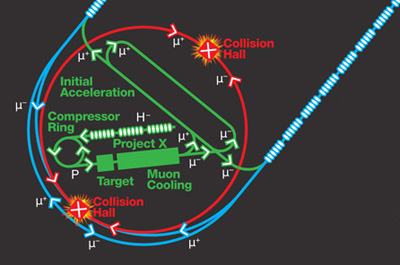
How Does a Muon Collider Work?
A muon collider complex would comprise several machines and many different components. Scientists across the world are developing and testing them.
Proton accelerator
To create lots of muons, scientists use a high-intensity proton accelerator that steers protons into a target. The collisions create short-lived particles called pions. Within 50 meters the pions decay into muons and neutral particles called neutrinos. The muons have an energy of about 200 MeV.
Capture cavities
Magnets guide the muons into and through a set of radiofrequency cavities. The electric field inside the cavities increases the energy of slow muons and decreases the energy of the fast muons, thereby reducing their spread in energy and transforming the continuous stream of muons into separate bunches. At this stage, the size of the muon bunches is still very large and the beam is still diverging as the muons are traveling in slightly different directions.
Muon cooling
Scientists are developing ionization cooling channels to reduce the transverse size of a muon beam. The channels reduce the transverse speed of the particles and produce very bright, focused beams, ready to be accelerated to high energies.
Acceleration
Radiofrequency cavities are a quick and efficient way to accelerate muons to high energies. Each cavity resembles a pearl necklace pulled into a straight line. Running through the string of pearls, or cells, is an electric field that oscillates between positive and negative. The oscillations are timed to push and pull charged particles from cell to cell.
Collider
Once the muons have reached their final energy, they are injected into the muon collider. Positively charged muons traverse the collider ring in one direction, and negatively charged muons travel in the opposite direction. Magnets steer the particles into a collision point at the center of a large collision detector. Muons that do not collide continue to travel along the ring and return to the collision point a fraction of a second later.




